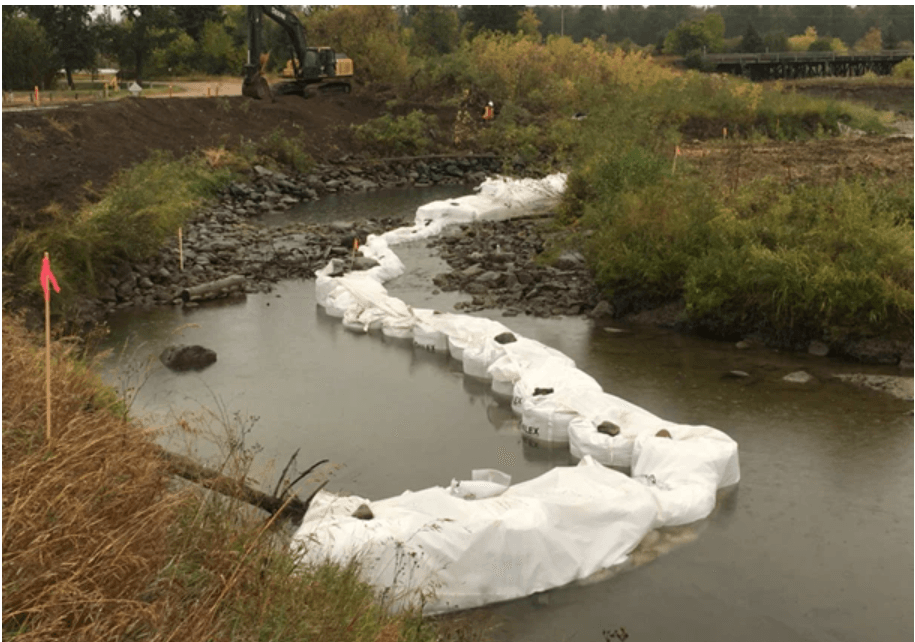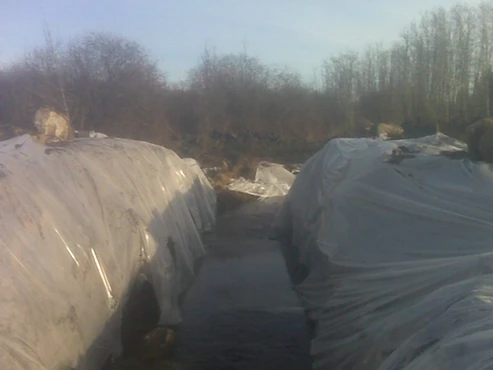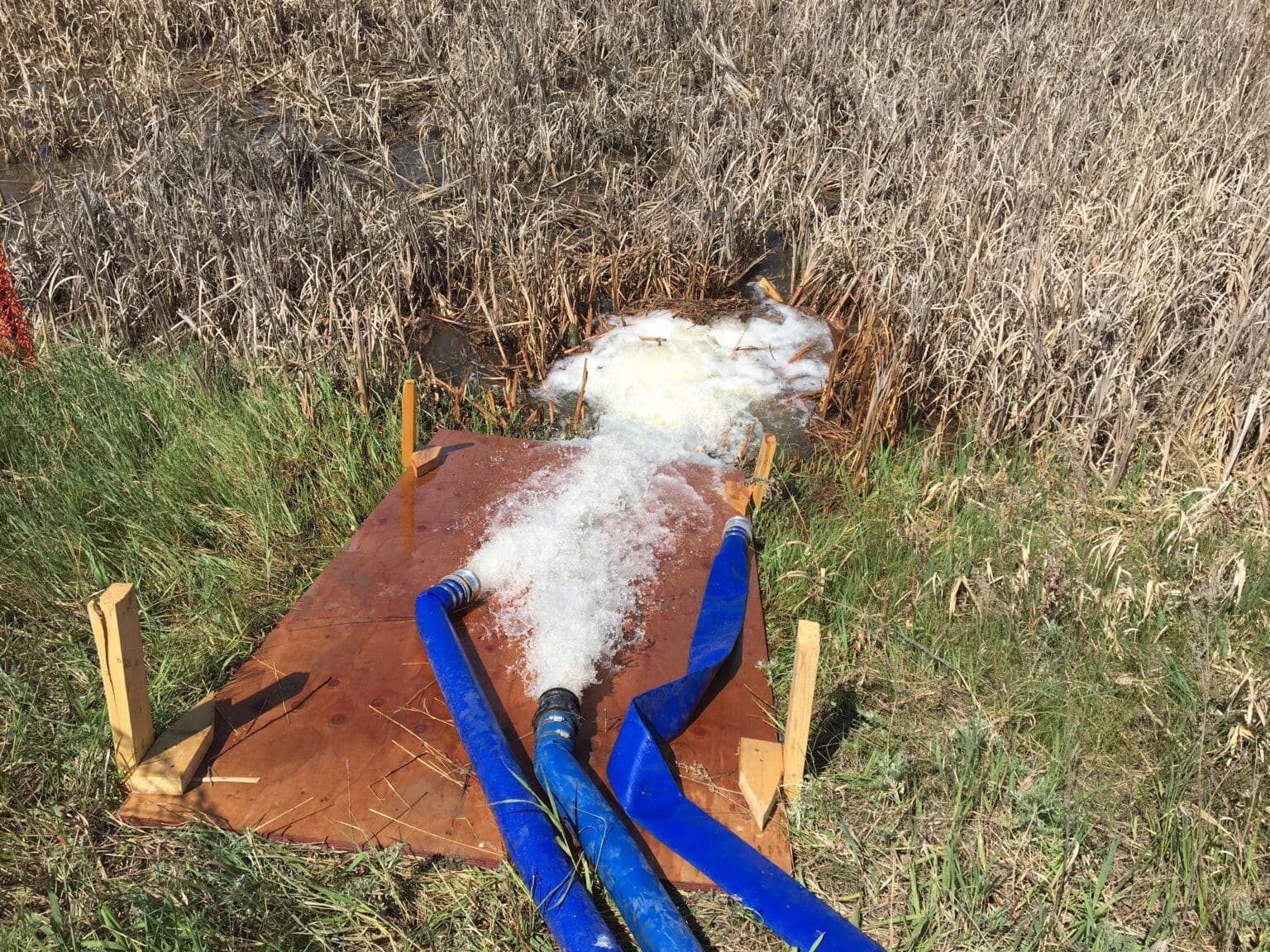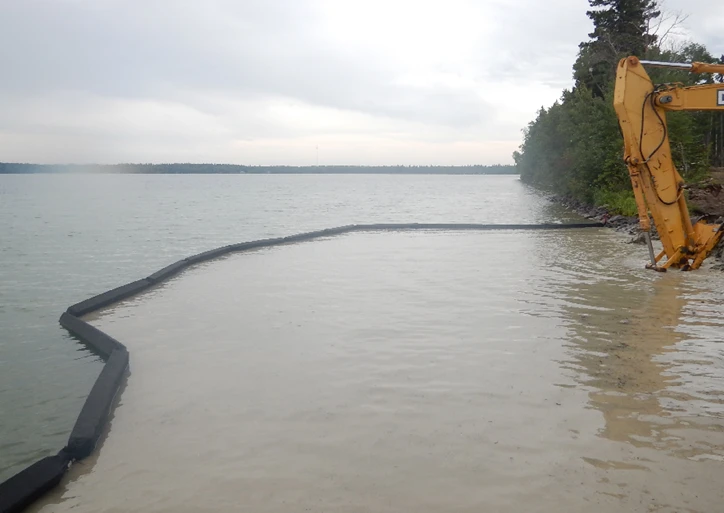
Site Isolation, Maintaining Downstream Flow and Dewatering
Site Isolation, Maintaining Downstream Flow and Dewatering
Working in water can have a significant impact on Saskatchewan’s aquatic habitats. To minimize potential impacts to our lakes and rivers, you may need to isolate your in-water construction work from flowing water, in the case of a river or stream, or adjacent water, in the case of a lake. Well-planned and implemented site isolation generally covers the following steps:
- Isolating the work area
- Maintaining downstream flows
- Performing a fish salvage
- Dewatering
(Please see Sample Site Isolation Plan for work occurring on a creek)
Isolating your work site
Before starting a project that involves working directly in water (such as the installation of a culvert or a large water intake), you may need to isolate your worksite from the main lake or stream to minimize disturbance to areas next to or downstream from your work. Site isolation allows you to work “in the dry,” even if your project requires work to occur below the bank.
The information below considers work that will occur in flowing water (e.g., a small river or stream); however, work that needs to occur in still water (e.g., a lake) or only on a small section of shoreline on a large river would follow similar advice, but would not likely need to address maintaining flows outside of the work area.
Coffer Dams and Acceptable Materials
You will need to determine how best to isolate your works from a lake or stream. Often a coffer dam is built to surround the work area – but be aware only non-erodible materials are typically allowed for this kind of work.
Construct a coffer dam using clean, non-erodible materials such as sand/gravel bags, sheet piles, AquaDamsTM or large bulk bags filled with sand or gravel. Earthen (i.e. soil) berms, which are more likely to erode and wash away in water, are not typically allowed. Sandbags are often wrapped or lined with heavy poly plastic for a better seal (that will minimize water entering the work area).
Before water flows are cut off, you must have a method to move water around the site. This means that before you install the upstream dam, you must plan for pumps or a diversion channel to ensure you maintain downstream flows.

Maintaining downstream flow
To prevent drying up downstream habitats on a stream or river, you must maintain one hundred per cent of the downstream flow. Ensure you have a plan and equipment ready to do this. If you will be using a diversion channel to move water around the site, you must build it before you place the coffer dam, and you should line it with rock and a geotextile fabric or heavy poly plastic to prevent scour and erosion.
If bypassing water using pumps, the pumps must be sized to handle flows, including potential high-flow situations such as rainfall or runoff events. If using pumps, you must check them to ensure flows are not cut off if pumps should fail. A backup pump should be set up and ready to go in the event the main pump fails. It is not advisable to conduct work that will require isolation and maintaining flow during spring melt, as stream flows are highly variable at this time of year and it is difficult to maintain flow.
- Pump intakes must not disturb the lake bottom/streambed. You must screen pump intakes used in fish-bearing watercourses to prevent entrainment and impingement of fish. Properly sized screens will prevent fish from being sucked into the pump or against the screen. For more information on screening requirements, please see Fisheries and Oceans Canada’s (DFO) Fish Screen Guidelines.
- Water re-entering the watercourse from the pumping work must be clear of sediment (equal or better water clarity than the receiving water). You should release the water into a well-vegetated or an armoured area to prevent any scouring or erosion to the bed and bank
Fish Salvage
Once you isolate the site from the main water, and before starting any in-water work such as dredging, excavation or dewatering of the site, you must ensure fish are properly removed from the isolated work area. Once a salvage has been completed, fish should not be able to re-enter the isolated site. Fisheries biologists typically perform fish removal using appropriate equipment. A Fish Salvage Permit must be obtained from the Saskatchewan Ministry of Environment (MoE) before handling or capturing of any fish. You can obtain a permit from MoE (fisheries.permits@gov.sk.ca), or the fisheries staff working with you will have already obtained the permit. To protect fish during sensitive life stages (such as spawning), in-water work and the use of site isolation is not typically allowed during the Restricted Activity Timing Window .
Definitions
Bed: That portion of the water body typically(but not always) covered by water.
Bank: The rising ground bordering a water body that serves to confine the water to a channel or bed.
Boundary: The line of elevation contour surrounding a water body or watercourse where
the aquatic vegetation and terrestrial plant species known to tolerate water saturated soils
change entirely to terrestrial vegetation tolerating little or no soil saturation and includes a minimum surrounding area of five meters measured outward from the top of the bank.
Coffer dam: A watertight structure or enclosure (usually temporary) built in a portion of a watercourse or water body to isolate work from the main watercourse or water body. The isolated is intended to prevent or minimize sediment-laden water associated with the construction work from entering downstream or adjacent areas. The inside working area is often pumped dry.
Fish salvage: Salvaging fish from a site means you catch the fish within the isolated area and release them alive and unharmed downstream or outside of your isolated site.

Dewatering
Once the coffer dams are in place and water is being bypassed around the site, and the fish salvage has been completed to the required standards, you can begin dewatering your work area. Often water being pumped out of the isolated work site will contain suspended sediment; you will need to remove this sediment from the water before water can re-enter the watercourse. You will need to ensure the sediment-laden water (i.e. dirty water) is discharged into a vegetated area or into a settling basin large enough to allow the sediment to settle out. Vegetated areas can help settle out fine sediment and these areas are less likely to scour and erode from the discharge.

- Protect all pump discharge areas from scour and erosion with rock, geotextile fabric or some other energy-dissipating device. Pumped water must not cause erosion or further introduce sediment into the watercourse. Remove the energy-dissipating material when works are complete.
- Monitor pumps and downstream flows. Sediment-laden water (i.e. dirty water) from the work site must not re-enter the watercourse.
Note: if water continues to enter your isolated site, dewatering may need to continue as you are working. This will depend on the nature of your site. Upon completion of your work in the isolated area, you must remove all equipment and cofferdam materials.
- In flowing water, remove the downstream isolation berm first and then slowly remove the upstream dam, allowing water to re-enter the channel previously isolated. You must completely remove dams from the watercourse and return the bank and bottom to pre-disturbance conditions.
- To prevent water from rushing into the work site, consider pumping water into the isolated work area to equalize the pressure on both sides of the coffer dam before breaching the coffer dam.
Note: if water continues to enter your isolated site, dewatering may need to continue as you are working. This will depend on the nature of your site.
Upon completion of your work in the isolated area, you must remove all equipment and cofferdam materials.
- In flowing water, remove the downstream isolation berm first and then slowly remove the upstream dam, allowing water to re-enter the channel previously isolated. You must completely remove dams from the watercourse and return the bank and bottom to pre-disturbance conditions.
- To prevent water from rushing into the work site, consider pumping water into the isolated work area to equalize the pressure on both sides of the coffer dam before breaching the coffer dam.
If the work you are planning will require a diversion channel to bypass water around the site, or If you will be pumping water to low or vegetated areas to manage sediment, be sure to confirm you are allowed to use the land for these purposes. Appropriate land control and access are also the responsibility of the project proponent.

Wet isolation
For some projects, it may be acceptable to do the work without dewatering the work area, but still isolating the work area from the rest of the water body. This is often done using floating or staked sediment barriers to contain suspended sediment within the work area. It is important that the measures are designed for your expected site conditions (e.g., depth of water, wave action) and installed according to the manufacturer’s directions and best management practices. The sediment barriers must also be routinely inspected to ensure they are functioning as intended. Once the project is complete, sediment barriers must remain in place long enough (often several days) to allow suspended sediment to settle to the bottom of the water body before removal.
The information on this webpage is intended to help plan your project; it is not an approval to conduct any work in or near water. It is the project proponent’s (the person completing or owning the project) responsibility to ensure that proper site isolation occurs. The project proponent must respect all municipal, provincial and federal legislation (e.g., Fisheries and Oceans Canada) that applies to the work being carried out. Please contact the Water Security Agency if you have further questions, or to apply for an Aquatic Habitat Protection Permit.
Contact information
Water Security Agency, Aquatic Habitat Protection
300-2365 Albert Street
Regina, SK S4P 4K1
306.787.0726
Also Contact: Municipal authority or provincial park for your shoreline area as some have bylaws about projects within water bodies. The Ministry of Environment may require a Crown Land Disposition if your project is located within Crown resource land visit http://www.environment.gov.sk.ca/permits/ then click on Crown Land Disposition – Lease or Permit.
An Experienced Team
We love our Saskatchewan waterways, and we also know a lot about them. If you need help finding information or determining if your shoreline or water-related project needs a permit, we can help! Use the contact form or give us a call to get started.